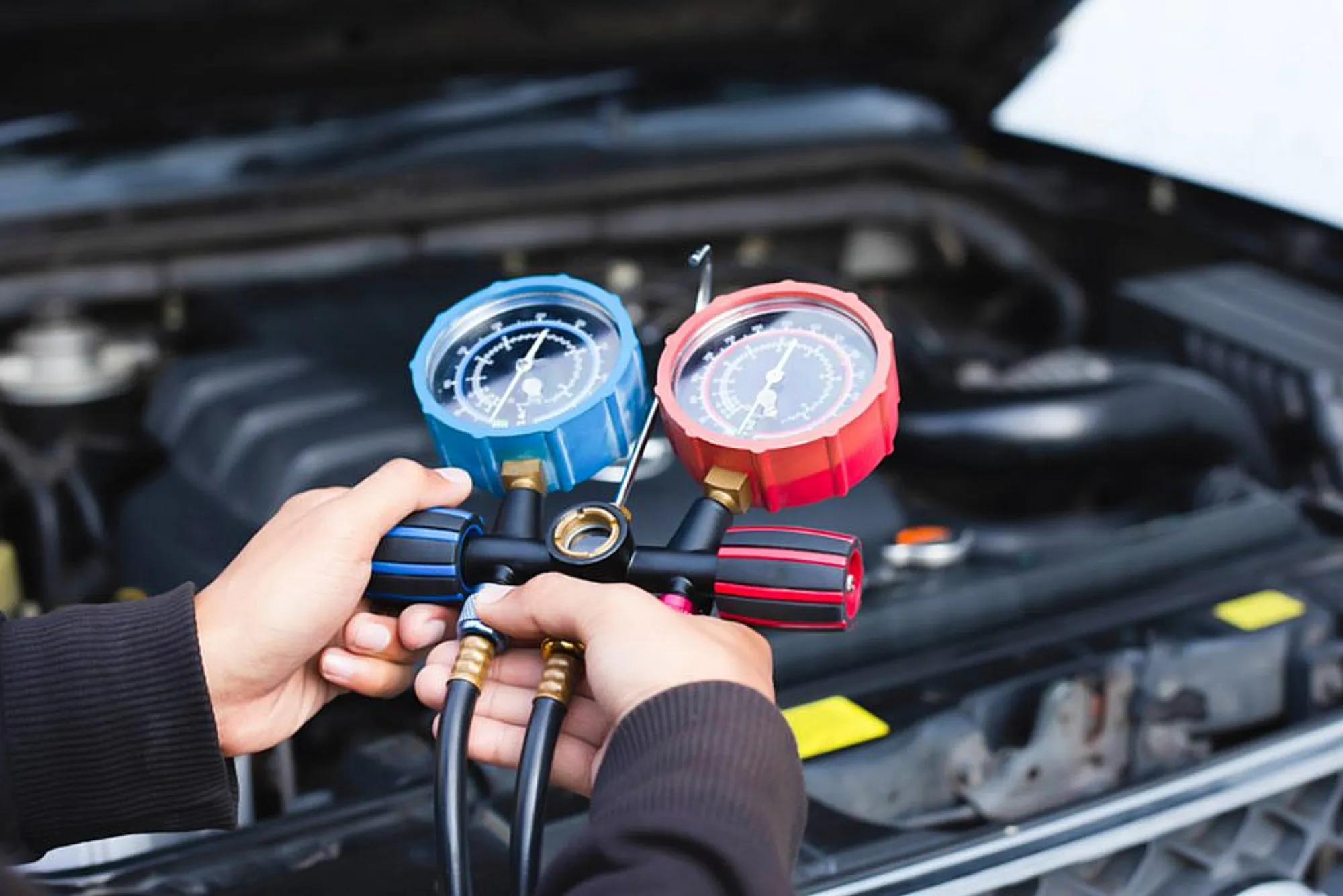Auto air conditioning systems play a crucial role in ensuring comfort during drives, particularly in hot weather conditions. However, like any other mechanical system, they are prone to wear and tear, necessitating repairs and maintenance. In this guide, we’ll delve into the intricacies of auto AC repair, covering common issues, diagnosis techniques, repair options, and the importance of professional services. We’ll also introduce Muhammad Hasnain AC Repairing Center as a reliable solution for your auto AC needs.
Understanding Auto AC Systems
In the scorching heat of summer or the freezing chill of winter, a properly functioning automotive air conditioning (AC) system is a lifesaver. Understanding how these systems work is crucial for diagnosing issues and ensuring optimal performance. This article delves into the intricacies of auto AC systems, shedding light on their components and functionality.
Components of Auto AC Systems: Auto AC systems are intricate assemblies comprising several key components. At the heart of the system lies the compressor, responsible for pressurizing the refrigerant gas. The refrigerant circulates through the system, absorbing and dissipating heat. The condenser then cools the refrigerant, converting it from a gas to a liquid. The liquid refrigerant passes through the expansion valve, where it undergoes a pressure drop, facilitating evaporation. This process occurs in the evaporator, which absorbs heat from the cabin air, thus cooling it. Finally, the refrigerant returns to the compressor to restart the cycle.
Functionality and Role of Each Component: Each component plays a crucial role in the overall functionality of the auto AC system. The compressor acts as the system’s “heart,” initiating the refrigeration cycle. It pressurizes the refrigerant, enabling efficient heat exchange. The condenser, typically located in front of the vehicle’s radiator, dissipates heat from the refrigerant, causing it to condense into a liquid. The expansion valve regulates the flow of refrigerant into the evaporator, controlling the system’s temperature and pressure. The evaporator absorbs heat from the cabin air, creating a cool breeze for occupants.
Importance of Regular Maintenance: Regular maintenance is paramount for ensuring the longevity and efficiency of auto AC systems. Routine inspections can detect potential issues before they escalate, preventing costly repairs. Maintenance tasks may include checking refrigerant levels, inspecting hoses and connections for leaks, and cleaning or replacing air filters. Additionally, lubricating moving parts and verifying proper belt tension can optimize system performance. Neglecting maintenance can lead to diminished cooling capacity, increased fuel consumption, and eventual system failure.
Signs of Auto AC Problems
Your vehicle’s air conditioning (AC) system is your best friend during hot summer days, providing relief from the sweltering heat. However, like any mechanical system, auto AC systems can experience issues over time. Recognizing the signs of AC problems early on is crucial for preventing discomfort and costly repairs. In this article, we’ll explore common indicators that your auto AC system may be malfunctioning, empowering you to take timely action.
Common Symptoms of Auto AC Problems
Weak or Inconsistent Cooling
One of the most apparent signs of AC trouble is a decrease in cooling performance. If your AC system is blowing warm or mildly cool air instead of cold air, it could indicate various issues, such as refrigerant leaks, compressor malfunction, or clogged filters.
Unusual Noises
Strange noises emanating from your AC system, such as rattling, buzzing, or grinding sounds, should not be ignored. These noises could signify a range of problems, including compressor issues, worn-out bearings, or loose components.
Foul Odors
If you notice unpleasant odors, such as musty or moldy smells, when you turn on your AC, it could be a sign of mold or bacteria growth within the system. This can occur due to moisture buildup in the evaporator or clogged drainage tubes.
Frequent Cycling On and Off
A healthy AC system should cycle on and off periodically to maintain the desired cabin temperature. However, if you observe frequent or rapid cycling, it could indicate an underlying issue, such as low refrigerant levels, a faulty thermostat, or a malfunctioning sensor.
Leaking Fluids
Puddles or stains of refrigerant or water underneath your vehicle may indicate a leak in the AC system. Refrigerant leaks not only impair cooling efficiency but can also pose environmental and health risks.
Identifying Potential Problems Early On: Early detection of AC problems can prevent minor issues from escalating into major repairs. Regularly monitor your AC system for any changes in performance, unusual sounds, or odors. Additionally, pay attention to warning lights on your vehicle’s dashboard, as they may indicate AC-related issues, such as low refrigerant levels or system malfunctions. Promptly addressing these signs can save you time, money, and discomfort in the long run.
Importance of Prompt Action: Ignoring signs of AC problems can lead to further damage and inconvenience. In addition to compromising comfort, unresolved AC issues can strain other components of your vehicle, leading to costly repairs down the line. By taking prompt action at the first sign of trouble, you can prevent potential breakdowns and ensure that your AC system operates smoothly throughout the year.
Diagnosing Auto AC Problems
A malfunctioning automotive air conditioning (AC) system can turn a pleasant drive into a sweltering ordeal. Diagnosing AC problems accurately is essential for effective repairs and restoring comfort to your vehicle’s cabin. In this article, we’ll delve into the diagnostic process for auto AC systems, equipping you with the knowledge to identify and address issues promptly.
Overview of Diagnostic Techniques: Diagnosing auto AC problems requires a systematic approach and a combination of techniques. Automotive technicians often begin by conducting a visual inspection of the AC system, checking for obvious signs of damage, leaks, or wear. They may then employ specialized diagnostic tools, such as pressure gauges, thermometers, and leak detectors, to assess system performance and identify underlying issues. Additionally, electronic diagnostic scanners can interface with the vehicle’s onboard computer system to retrieve fault codes and pinpoint specific problems.
Importance of Thorough Inspection: A thorough inspection is paramount for accurate diagnosis and effective repairs. Technicians meticulously examine each component of the AC system, including the compressor, condenser, evaporator, expansion valve, and associated hoses and connections. They assess refrigerant levels, monitor pressure readings, and inspect electrical connections for signs of corrosion or damage. By scrutinizing every aspect of the AC system, technicians can uncover hidden issues and ensure comprehensive repairs.
Role of Specialized Equipment: Specialized diagnostic equipment plays a crucial role in pinpointing AC problems with precision. Pressure gauges allow technicians to measure refrigerant pressure levels and identify leaks or blockages within the system. Thermometers help assess temperature differentials across various components, aiding in the detection of faulty parts. Leak detectors use ultraviolet dye or electronic sensors to pinpoint refrigerant leaks, facilitating timely repairs. Advanced diagnostic scanners interface with the vehicle’s onboard computer system, providing real-time data and diagnostic codes to guide the repair process.
Diagnostic Challenges and Solutions: Diagnosing auto AC problems can pose challenges due to the system’s complexity and the interconnectedness of its components. However, experienced technicians leverage their expertise and diagnostic tools to overcome these challenges effectively. They rely on a combination of visual inspection, diagnostic testing, and problem-solving skills to identify the root cause of AC issues. By adopting a systematic approach and staying updated on industry best practices, technicians can diagnose and resolve even the most elusive AC problems.
Common Auto AC Repairs
Maintaining a functional automotive air conditioning (AC) system is crucial for a comfortable driving experience, especially during hot summer months. However, like any mechanical component, auto AC systems can encounter issues over time. Understanding common AC problems and their solutions is essential for keeping your vehicle’s interior cool and comfortable. In this article, we’ll explore the most prevalent auto AC repairs and the steps involved in addressing them.
Refrigerant Leaks and Recharging: Refrigerant leaks are a common issue that can compromise the cooling efficiency of your AC system. Technicians use specialized tools to detect leaks, such as ultraviolet dye or electronic leak detectors. Once identified, leaks are repaired, and the system is recharged with the appropriate amount of refrigerant. Proper refrigerant levels are essential for optimal cooling performance and preventing further damage to the system.
Compressor and Condenser Repairs/Replacements: The compressor and condenser are critical components of the AC system responsible for pressurizing and cooling the refrigerant. Compressor failures are often characterized by loud noises, lack of cooling, or visible damage to the component. Similarly, condenser damage can result from impacts, corrosion, or debris accumulation. Depending on the extent of the damage, technicians may repair or replace these components to restore proper functionality to the AC system.
Evaporator Coil Issues and Solutions: The evaporator coil is responsible for absorbing heat from the cabin air, facilitating the cooling process. Over time, the evaporator coil may become clogged with dirt, dust, or debris, hindering its ability to efficiently transfer heat. Technicians may clean or replace the evaporator coil to restore optimal cooling performance. Additionally, issues such as refrigerant leaks or frost buildup on the evaporator coil may require specialized repairs to ensure proper function.
Electrical System Repairs: The electrical system plays a crucial role in controlling various components of the AC system, including the compressor, blower motor, and temperature sensors. Faulty electrical connections, blown fuses, or malfunctioning relays can disrupt AC operation and lead to cooling issues. Technicians conduct diagnostic tests to identify electrical problems and perform repairs to restore proper function to the AC system.
Other Common Repairs and Maintenance Tasks: In addition to the aforementioned repairs, technicians may perform a range of maintenance tasks to ensure the optimal performance of the AC system. These tasks may include replacing worn-out belts and pulleys, cleaning or replacing air filters, lubricating moving parts, and inspecting hoses and connections for leaks or damage. Regular maintenance is essential for preventing future issues and prolonging the lifespan of the AC system.
UAEMate is your trusted companion for navigating the diverse and dynamic landscape of the UAE. Specializing in personalized services and expert guidance, UAEMate ensures that expatriates and travelers alike experience the best of what the UAE has to offer. From cultural immersion to business opportunities, our platform connects you with the resources you need for a seamless and enriching journey. Discover the UAE with confidence and ease through UAEMate.
DIY vs. Professional Repair
When faced with auto air conditioning (AC) issues, vehicle owners often contemplate whether to tackle repairs themselves or seek professional assistance. While do-it-yourself (DIY) solutions may seem cost-effective, professional repair services offer expertise and reliability. In this article, we’ll explore the pros and cons of DIY vs. professional auto AC repair to help you make an informed decision for your vehicle’s needs.
DIY AC Repair
Cost Savings: DIY repairs may seem more economical upfront, as they eliminate labor costs associated with professional services.
Learning Experience: DIY repairs provide an opportunity for hands-on learning and a deeper understanding of your vehicle’s AC system.
Convenience: DIY enthusiasts enjoy the flexibility of working on their vehicles at their own pace and convenience, without scheduling appointments.
However, DIY AC repair has its drawbacks
Lack of Expertise: Without proper training and experience, DIYers may misdiagnose problems or perform repairs incorrectly, leading to further damage.
Safety Risks: Working with refrigerants and electrical components can pose safety hazards if not handled properly, risking injury or damage to the vehicle.
Limited Resources: DIYers may lack access to specialized diagnostic tools and equipment, hindering their ability to diagnose and address complex AC issues effectively.
Professional AC Repair
Expertise and Experience: Professional technicians undergo extensive training and have years of experience diagnosing and repairing auto AC systems, ensuring accurate and efficient repairs.
Quality Assurance: Professional repair centers use state-of-the-art diagnostic equipment and high-quality replacement parts, guaranteeing reliable and long-lasting repairs.
Warranty Coverage: Many professional repair services offer warranties on parts and labor, providing peace of mind and protection against future issues.
However, professional AC repair also has its limitations
Cost: Professional repair services typically entail labor costs in addition to parts, making them more expensive than DIY solutions.
Scheduling Constraints: Depending on the workload of the repair center, scheduling appointments for AC repairs may require some wait time, inconveniencing vehicle owners.
Dependency on Others: Relying on professional technicians means entrusting your vehicle to others, which may not be ideal for some DIY enthusiasts who prefer hands-on involvement.
Choosing a Reliable Auto AC Repair Service
Selecting the right auto air conditioning (AC) repair service is crucial for ensuring efficient repairs and reliable performance of your vehicle’s cooling system. With numerous options available, it’s essential to consider factors such as experience, expertise, and customer satisfaction when making your decision. In this article, we’ll explore key considerations to help you choose a reliable auto AC repair service with confidence.
Factors to Consider
Experience and Expertise
Look for repair centers with a proven track record of experience in diagnosing and repairing auto AC systems. Experienced technicians are equipped with the knowledge and skills to handle a wide range of AC issues effectively.
Consider the expertise of the technicians. Ideally, the repair center should employ certified technicians who have undergone specialized training in automotive HVAC systems.
Reputation and Reviews
Research online reviews and testimonials from previous customers to gauge the reputation of the repair service. Positive reviews and high customer satisfaction ratings are indicators of quality service.
Seek recommendations from friends, family, or colleagues who have had positive experiences with auto AC repair services. Word-of-mouth referrals can provide valuable insights into the reliability and professionalism of repair centers.
Quality of Equipment and Parts
Inquire about the quality of diagnostic equipment and replacement parts used by the repair service. State-of-the-art diagnostic tools ensure accurate diagnosis, while high-quality parts ensure durability and reliability.
Choose repair centers that use genuine OEM (Original Equipment Manufacturer) or high-quality aftermarket parts to maintain the integrity of your vehicle’s AC system.
Warranty and Guarantees
Evaluate the warranty and guarantees offered by the repair service. Reputable repair centers stand behind their workmanship and offer warranties on parts and labor.
Clarify any terms and conditions associated with warranties to ensure comprehensive coverage for potential future issues.
Customer Service and Communication
Assess the level of customer service and communication provided by the repair service. Friendly and knowledgeable staff who prioritize customer satisfaction contribute to a positive repair experience.
Choose repair centers that are transparent and communicative throughout the repair process, providing updates on the status of repairs and addressing any concerns promptly.
Preventative Maintenance Tips
Preventative maintenance is key to ensuring the longevity and efficiency of your vehicle’s air conditioning (AC) system. By implementing proactive measures, you can prevent potential issues, optimize performance, and enjoy a comfortable driving experience year-round. In this article, we’ll explore essential preventative maintenance tips to keep your auto AC system running smoothly.
UAEBusinessman is a leading resource for insights and information on successful entrepreneurs and business ventures across the UAE. It offers detailed profiles, industry trends, and practical advice for aspiring and established businessmen. With a focus on innovation and growth, UAEBusinessman connects professionals with key strategies and success stories from the region’s dynamic business landscape.
Regular Inspections
Schedule routine inspections of your AC system to detect any signs of wear, leaks, or damage early on. Check for visible damage to components such as hoses, connectors, and the compressor.
Monitor refrigerant levels and ensure they are within the manufacturer’s recommended range. Low refrigerant levels can indicate a leak or other underlying issues that require attention.
Clean or Replace Air Filters
Dirty or clogged air filters can restrict airflow and reduce the efficiency of your AC system. Regularly inspect and clean or replace air filters according to the manufacturer’s recommendations.
Clean filters improve air quality inside the vehicle and help prevent contaminants from entering the AC system, prolonging its lifespan.
Keep Condenser and Evaporator Coils Clean
Clean the condenser and evaporator coils periodically to remove dirt, dust, and debris that can accumulate over time. Use compressed air or a soft brush to gently clean the coils without damaging them.
Dirty coils can impede heat transfer and reduce cooling efficiency. Keeping them clean ensures optimal performance of your AC system.
Check and Lubricate Moving Parts
Inspect and lubricate moving parts such as the compressor clutch and blower motor regularly to reduce friction and wear. Lubrication prevents premature failure and ensures smooth operation of these components.
Use manufacturer-recommended lubricants and follow proper lubrication procedures to maintain optimal performance and extend the lifespan of moving parts.
Test System Performance
Periodically test the performance of your AC system to ensure it is cooling effectively. Check for any unusual noises, odors, or fluctuations in cooling performance.
If you notice any issues, such as weak airflow or warm air blowing from the vents, schedule a diagnostic check-up with a qualified technician to identify and address the underlying cause.
Maintain Proper Ventilation
Ensure proper ventilation inside the vehicle by keeping air vents open and unobstructed. Blocked vents can restrict airflow and reduce cooling efficiency.
Clean debris or obstructions from vents regularly to maintain optimal airflow distribution throughout the cabin.
Auto AC repair is essential for ensuring comfort and safety during drives, especially in hot weather. By understanding common issues, recognizing signs of problems, and seeking professional services like those provided by Muhammad Hasnain AC Repairing Center, you can keep your auto AC system running smoothly for years to come. Remember, staying cool on the road starts with proactive maintenance and timely repairs.




